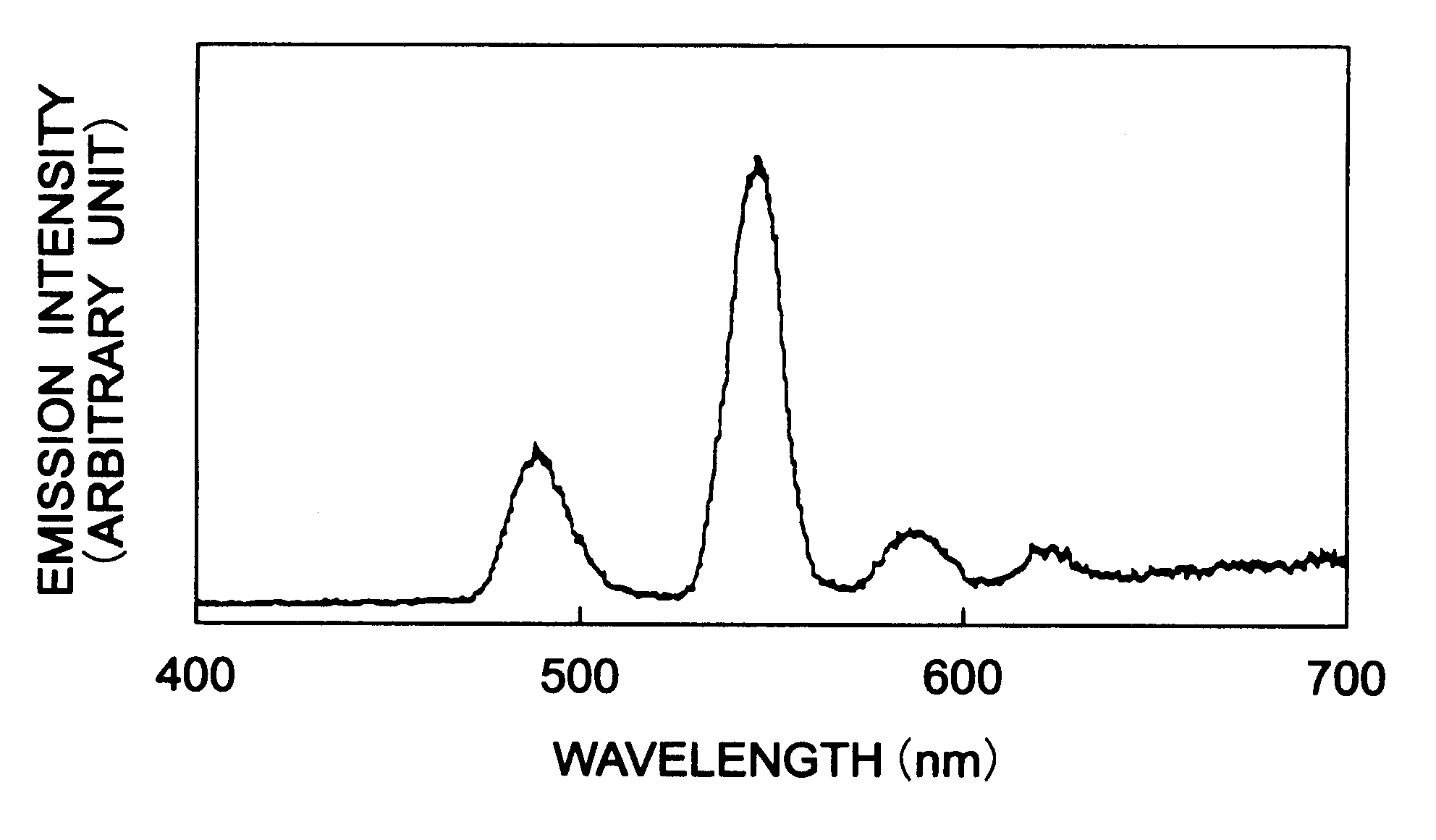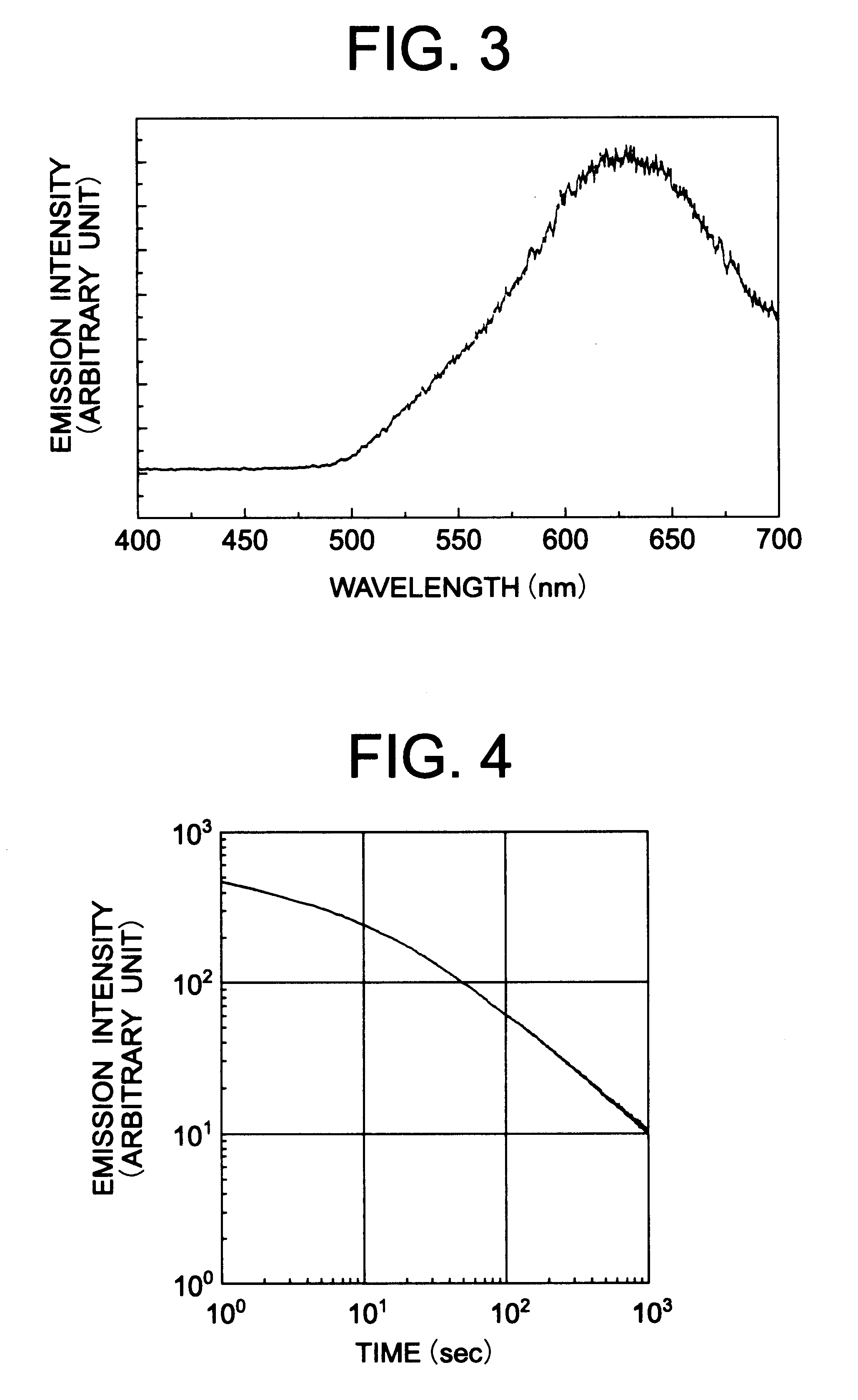Oxide glass showing long afterglow and accelerated phosphorescence
a technology of phosphorescence and phosphorescence, which is applied in the direction of luminescent compositions, luminescent dosimeters, chemistry apparatus and processes, etc., can solve the problems of difficult observation of emission, limited coating, and increase in opaqueness
- Summary
- Abstract
- Description
- Claims
- Application Information
AI Technical Summary
Problems solved by technology
Method used
Image
Examples
examples 2 to 29
Raw materials were mixed according to corresponding weight ratios and melted in the similar manner to Example 1 to obtain various glass compositions.
When the resulting glasses in Examples 2 to 29 were excited by an ultraviolet ray of 254 nm, there were obtained similar spectra to FIG. 1 exhibiting afterglow phosphorescence similar to Example 1 and change of emission intensity of thereof with time, similar to FIG. 2. The change in the case of Example 14 is also shown in FIG. 2(b). When these glasses were irradiated by X-rays in the similar manner to Example 1 and then by a semiconductor laser of 800 nm, a green photostimulated luminescence was visually observed.
example 30
Raw materials were mixed according to weight ratios of Example No. 30 shown in Table 6 to give a composition of Example No. 30 shown in Table 7. The thus prepared raw materials were melted at a temperature of 1100 to 1500.degree. C. for 1 to 3 hours, allowed to flow in a metallic mold and shaped to obtain a glass.
When the resulting glass was excited by an ultraviolet ray of 254 nm, red afterglow phosphorescence was exhibited to give a phosphorescent spectrum shown in FIG. 3. A change of emission intensity with time as to the glass excited by the UV ray of 254 nm is shown in FIG. 4. When this glass was irradiated by X-rays and then by a semiconductor laser of 800 nm, a red photostimulated luminescence was visually observed.
examples 31 to 35
Raw materials were mixed according to corresponding weight ratios and melted in the similar manner to Example 30 to obtain various glasses.
When the resulting glasses in Examples 31, 34 and 35 were excited by an ultraviolet ray of 254 nm, there were obtained similar phosphorescent spectra to FIG. 3 exhibiting red afterglow phosphorescence similar to Example 30 and change of emission intensity of thereof with time, similar to FIG. 4. When these glasses were irradiated by X-rays in the similar manner to Example 30 and then by a semiconductor laser of 800 nm, a red photostimulated luminescence was visually observed.
When glasses obtained in Examples 32 and 33 by mixing both of MnO and Tb.sub.2 O.sub.3 were irradiated by an ultraviolet ray of 254 nm, on the other hand, two peaks of FIG. 1 and FIG. 3 were simultaneously observed in phosphorescent spectra exhibiting orange afterglow phosphorescence. After irradiating an ultraviolet ray of 254 nm, there was obtained change of emission intens...
PUM
| Property | Measurement | Unit |
|---|---|---|
| temperature | aaaaa | aaaaa |
| chemical composition | aaaaa | aaaaa |
| photostimulated luminescence | aaaaa | aaaaa |
Abstract
Description
Claims
Application Information
 Login to View More
Login to View More - R&D
- Intellectual Property
- Life Sciences
- Materials
- Tech Scout
- Unparalleled Data Quality
- Higher Quality Content
- 60% Fewer Hallucinations
Browse by: Latest US Patents, China's latest patents, Technical Efficacy Thesaurus, Application Domain, Technology Topic, Popular Technical Reports.
© 2025 PatSnap. All rights reserved.Legal|Privacy policy|Modern Slavery Act Transparency Statement|Sitemap|About US| Contact US: help@patsnap.com



